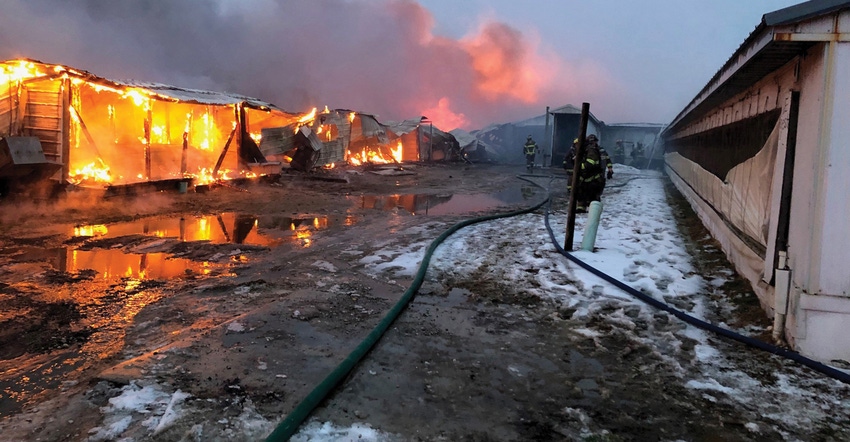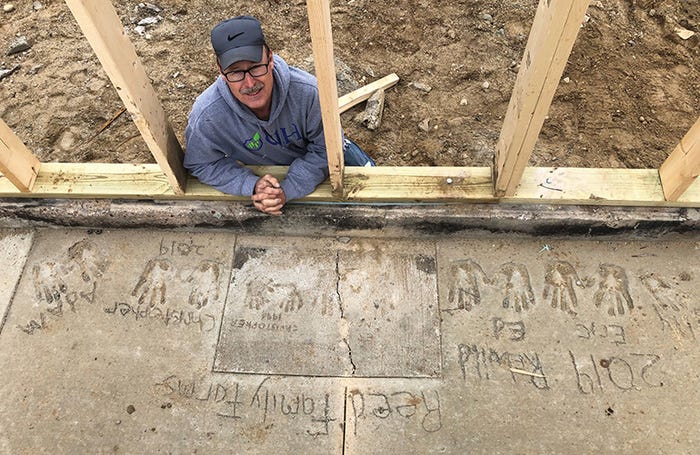Farrowing after fire
Michigan producer loses part of system, keeps pork production flowing.

After being diagnosed with non-Hodgkin lymphoma in April 2018 and undergoing four three-week cycles of chemotherapy and three weeks of daily radiation treatments at the Mayo Clinic in Rochester, Minn., Ed Reed couldn’t wait for a fresh start in 2019.
“I was done July 27, 2018, and I was really, really happy,” says the Marcellus, Mich., pork producer. “I told my boys, ‘Man, I can’t wait until 2019. I want to forget about this 2018. It was a bad year.’”
However, it wasn’t too long after the new year began when tragedy struck the Reed family again.
It was 4:55 p.m. on Feb. 12 when the alarm came through that eight rooms in the farrowing building were hot. Reed, who was in the shop, had sent his staff home just 25 minutes prior, as the weather conditions were starting to get worse. Temperatures were holding steady at 10 degrees F and the wind was blowing 30 mph. As soon as Reed opened the door to the shop, he saw black smoke coming out of every crack in the farrowing barn.
“There’s nothing that makes your heart come up into your throat any faster than to see flames coming through the roof of your building,” Reed says. “It’s one of those things etched in your memory forever.”
After calling 911, Reed’s first mission was to run through the smoke and shut off all of the seven 1,000-gallon propane tanks that were only 10 feet from the building.
By the time he got to the north end of the building, he noticed there wasn’t that much squealing or noise coming out of the farrowing barn; but as he got closer to the gestation barn, it just kept getting louder. Upon further inspection, Reed found the fans were sucking up the smoke and the fire from the farrowing building into the gestation building through the hallway. Once he opened the door to the farrowing barn, he saw that the flames were coming out of the ceiling inlets. He dropped the curtains down, shut the power off and waited for the fire department to come.
As soon as two sets of trucks from the fire department showed up, one half took the south side of the building, while Reed took the other half to the gestation barn.
“The farrowing was totally engulfed, and in the gestation barn there was lots of smoke, but there wasn’t any fire coming out the roof,” Reed says.
The firefighters then proceeded to get up on the roof to see where the fire was coming through the hallway. They took the building steel off and sprayed water in there. They also had an infrared camera, which helped them find the hot spots in the roof of the gestation building. Wherever they found those hot spots, they cut a hole in the ceiling and dropped the insulation out so that they could get to the fire.
No sows were lost in the gestation barn, although some did abort later due to the frigid temperatures. Reed describes the firefighters as flawless.
“They got the metal off, found the hot spots. It was just in time — otherwise the gestation barn would’ve been gone. The buildings are all 40 feet apart,” Reed says. “It was absolutely amazing that they saved that building.”

Damage was done
It was 6:19 p.m. when the electrical fire, which began in Room 11, was finally under control, and the farrowing barn was totally flat. While there were walls standing, the entire roof and complex had burned, and Reed Family Farms had lost all 500 sows inside.
“It was just absolutely awful,” Reed says. “The struggles that the fire department had, it was 10 degrees and it was blasted cold. Of course, we’re in rural Marcellus, Mich., and they couldn’t get water. They actually went to a creek about a mile-and-a-half away to suck water out of the creek.”
Looking back, Reed says it was a travesty that he did not have the correct fittings to hook up to the firetrucks, because his irrigation well could have supplied the water at 800 gallons a minute.
It took two long weeks to clean up after the fire.
“It was very, very difficult to clean up, because — as you can imagine — you have all those crates and all of that roof, metal and all that carnage,” Reed says. “The buildings are 82 feet wide, and you’ve got a 40-foot division between the buildings, so we had to drag all of that stuff — crates, dead pigs and everything — out one side of the building. That was tough: really, really tough.”

Like father, like son
One week later, it was Reed’s oldest son, Christopher, a former industrial engineer who had returned to the farm full time during Reed’s chemo and radiation treatments, who suggested they rebuild.
“Never in a million years would I have been able to navigate it, and I would never have rebuilt,” Reed says. “When we had this fire, I said to him, ‘Well, you know, we can rent these buildings, we can contract-finish — there are a lot of things we can do, and you can go be an engineer again.’ He said, ‘No, I want to rebuild this and be a pig farmer,’ so that was a wonderful thing.”
For Reed, who didn’t grow up on a pig farm and had a background in electrical engineering, those words were music to his ears. In 1993, he had joined his father-in-law and brother-in-law in the business, built his sow farm in 1994 with 1,400 sows and ran it until 1998, “when the market was really, really bad.”
“I contemplated maybe going and working as an engineer again,” Reed says. “Instead of doing that, I just bought the farm from my father-in-law, and I guess I jumped in headfirst and decided I was going to be a hog farmer.”
Today, Reed Family Farms has grown to 3,500 sows, finishing all of its own pigs. A partner in the Clemens Food Group processing plant in Coldwater, chairman of the board at GreenStone Farm Credit and a member of the Michigan Pork Producers Association, Reed was in no hurry to hang up his pork producer hat after the fire either.
Farrowing keeps flowing
The rebuild didn’t seem far-fetched to the Reeds. After all, their farm had been able to keep production flowing despite losing part of their system.
“I guess it’s a little comical, but we were unbelievably fortunate. In the order of events, we had the fire on Tuesday night the 12th; by the 13th, the state vet, Dr. Jim Kober, texted me with a name and number of a G and G Pork by Gun Lake, about 65 miles from us,” Reed says.
“The guy had decided to retire farrowing and had just finished the last set of pigs there, and their barn was just sitting empty.”
Two days later, the Reeds were farrowing pigs in the G and G barns.
It took some logistics and planning, but Reed’s son Christopher, Christopher’s girlfriend Rachel, and a couple other employees were soon posted up at G and G in travel trailers to run the farrowing operation.
Reed says it couldn’t have worked out any better.
“That’s how we stayed in business. I mean, you have a fire, and there’s no place for farrowing. All those sows are pregnant. What are you going to do? You know, they’re going to start having pigs three or four days after that fire, and it’s like, wow. There are 150 sows farrowing every week. You’re going to have to do something with them,” Reed says. “This was absolutely perfect.”
On the fast track
With production flowing smoothly again, the Reeds could then focus on the rebuild. They turned to Hog Slat Inc., who had built the original farm and had been involved in all the Reeds’ construction projects over the last 25 years.
In early March, Reed, along with oldest son Christopher and middle son Eric — who works for Hog Slat — made the trip down to Hog Slat’s corporate offices in Newton Grove, N.C., to look at equipment and other farms, and to get to work on specifications for the site.
Keeping the fire in mind, the Reeds followed Hog Slat’s recommendations, adding steel firewalls and fire doors and hardwiring the facility.
By mid-April, construction for the new farrowing facility had begun. “These guys put us on the fast track, once we had the specifications and got our equipment all built and delivered,” Reed says.
Just four short months later, the Reeds are farrowing back on their home site. “I love to do construction, but whenever contractors tell you, ‘Yeah, we can do it in half the time,’ you’re always, ‘Yeah, right.’ But they came in and worked, and that was awesome, absolutely awesome,” Reed says.
“It’s those relationships that I keep telling my oldest son about that in farming, in business or in general, are so important. Just having those personal relationships, so when you call somebody up and tell them that, ‘Hey, I’ve got a big problem here. I’m in trouble. I need your help today.’ ”
Before that first spark, here’s what every farm should consider
In addition to adding firewalls and fire doors, and not including outlets in the building, Ed Reed has put together a list of actions he wished he had done to prepare for a disaster such as a fire. He hopes that by sharing these tips, he can help other pork producers hope for the best and prepare for the worst:
Fire department once-over. Invite your local fire department to the farm to give firefighters an idea of what they’ll be dealing with in case of emergency. Show them how to shut the power off and where the equipment is on the farm.
Water plan. Have a plan for access to water. If he had the correct fittings, the firetrucks could have connected to his irrigation well. Reed says he has one friend with a cattle operation who had experienced a fire. That friend has now put some fire hydrants around his buildings.
Insurance review. Update insurance policies for the actual replacement cost of the buildings. Building costs can change, and different buildings can be worth more. Also, don’t be quick to cancel a policy you think you don’t need. After paying business continuation insurance for 25 years, Reed thought he would never use it and canceled. He lucked out being able to use the farrowing barn up the road, but realizes if the circumstances had been different, the farm wouldn’t have fared as well.
About the Author(s)
You May Also Like





